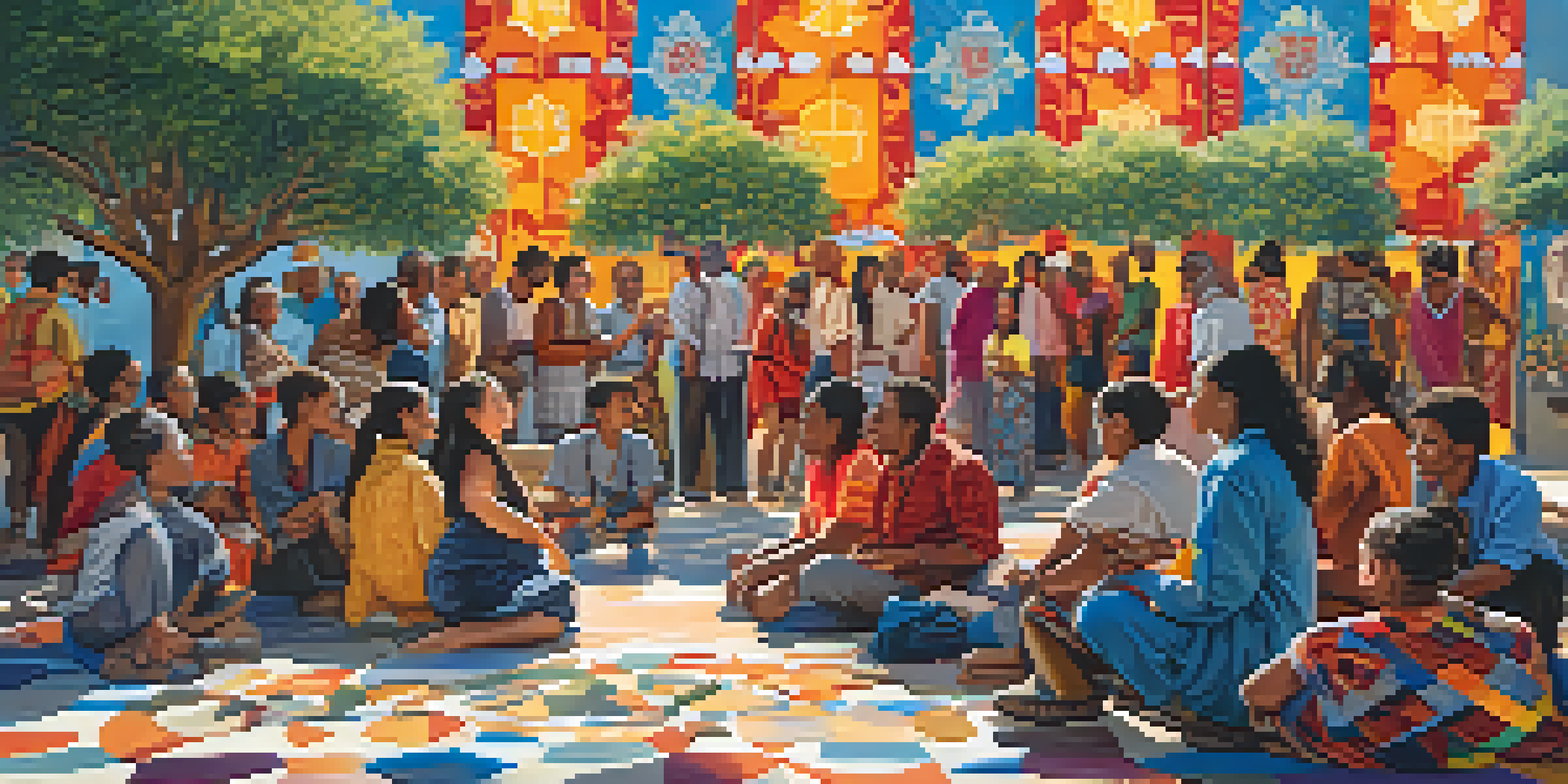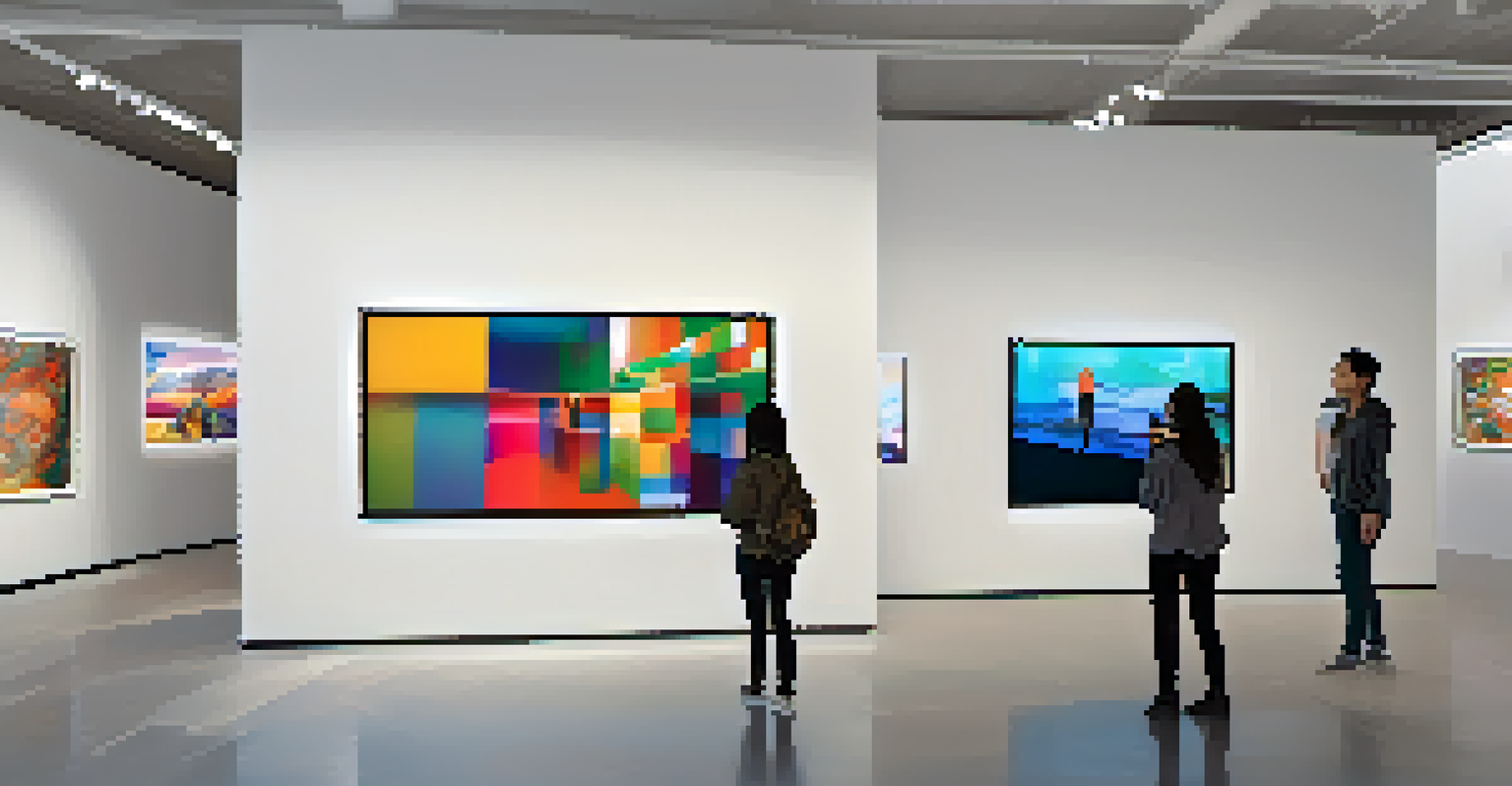Art as a Reflection of Multicultural Identities and Narratives

Understanding Multicultural Identities in Art
Multicultural identities are shaped by the blending of various cultural influences, and art serves as a mirror reflecting this diversity. Artists often draw from their unique backgrounds, telling stories that resonate with different communities. This interplay creates a rich tapestry of expression that can be both personal and universal, inviting viewers into new perspectives.
Art is the most beautiful of all lies; it is a reflection of the culture that creates it.
For example, consider the vibrant works of Frida Kahlo, whose paintings encapsulate her Mexican heritage while also addressing universal themes like pain and identity. Each brush stroke tells a story, connecting her personal experiences with broader cultural narratives. This ability to weave personal and collective identities into art is what makes it so powerful.
As we engage with multicultural art, we begin to appreciate the complexities of identity. It encourages us to reflect on our own experiences and the diverse narratives that shape our world, fostering a sense of empathy and understanding.
The Role of Art in Cultural Dialogue
Art acts as a vital medium for dialogue among cultures, enabling conversations that transcend language barriers. Through visual storytelling, artists invite us to explore themes of belonging, displacement, and community. This exchange becomes crucial in a globalized world where understanding different narratives is essential.

Take, for instance, the global impact of street art, which often reflects social issues pertinent to various cultures. Murals can convey messages of resistance, hope, and unity, engaging viewers in discussions about identity and belonging. By bridging gaps, art fosters connections that can lead to greater cultural appreciation.
Art Reflects Multicultural Identities
Art serves as a powerful medium for expressing and exploring the complexities of multicultural identities.
Moreover, art exhibitions that showcase multicultural artists create spaces for dialogue and reflection. These platforms allow diverse voices to be heard, paving the way for a richer understanding of the narratives that shape our societies.
Art as a Tool for Preservation of Cultural Heritage
Art plays a crucial role in preserving cultural heritage, capturing traditions, stories, and practices that might otherwise fade away. Artists often incorporate traditional techniques and motifs, ensuring that cultural legacies are honored and passed down through generations. This preservation is vital in maintaining a sense of identity.
The role of the artist is to make the revolution irresistible.
Consider Indigenous art forms, which often embody deep spiritual connections to land and ancestry. By creating works that reflect these traditions, artists not only celebrate their heritage but also educate others about its significance. This helps keep cultural narratives alive and relevant in contemporary society.
Furthermore, art festivals and community projects that focus on traditional crafts serve to rejuvenate interest in cultural practices. These initiatives not only preserve heritage but also encourage younger generations to engage with their roots, ensuring that these narratives continue to thrive.
Exploring Intersectionality Through Art
Intersectionality in art highlights how various aspects of identity—such as race, gender, and class—interact and impact experiences. Artists use their work to explore these intersections, providing insights into complex social dynamics. This approach enriches our understanding of how multicultural identities are not monolithic but rather layered and multifaceted.
For instance, the works of artists like Yayoi Kusama often delve into themes of mental health, femininity, and cultural identity, all while reflecting her unique experiences as a Japanese woman. By addressing these intersections, her art resonates with a diverse audience, inviting them to explore their own identities.
Globalization Shapes Artistic Expression
The influence of globalization allows artists to blend traditional and contemporary styles, enriching narratives and perspectives.
Through the lens of intersectionality, art becomes a powerful vehicle for social commentary. It challenges stereotypes, encourages dialogue, and prompts viewers to reflect on their own positions within the societal landscape.
The Impact of Globalization on Artistic Expression
Globalization has significantly influenced artistic expression, allowing for the exchange of ideas and styles across borders. Artists today often blend traditional elements with contemporary techniques, creating works that reflect a globalized experience. This fusion can lead to innovative art that resonates with a wider audience.
Consider the rise of Afrobeat music, which infuses traditional African rhythms with elements of jazz and funk. Artists like Burna Boy not only celebrate their cultural roots but also engage with global music trends, reflecting a multicultural identity. This cross-pollination of styles exemplifies how globalization enriches artistic narratives.
However, this blending can also raise questions about cultural appropriation versus appreciation. It’s essential for artists to navigate these waters thoughtfully, ensuring that the voices and stories of the cultures they draw from are respected and preserved.
Digital Art and Multicultural Narratives
The advent of digital art has opened new avenues for expressing multicultural narratives, allowing artists to reach audiences worldwide. Digital platforms enable the sharing of diverse stories and styles, breaking down geographical barriers. This accessibility promotes a global dialogue about identity and culture.
For example, social media has become a powerful tool for artists to showcase their work and connect with communities. Platforms like Instagram allow for immediate feedback and engagement, enabling artists to share their multicultural experiences in real-time. This instant connection fosters a sense of belonging and shared understanding.
Digital Platforms Enhance Art Sharing
Digital art and social media create accessible spaces for artists to share multicultural narratives and connect with global audiences.
As digital art continues to evolve, it’s crucial to recognize its role in shaping contemporary narratives. By embracing technology, artists can amplify their voices, challenge stereotypes, and celebrate the richness of multicultural identities.
Future Directions for Multicultural Art
As we look to the future, the importance of multicultural art in society will only continue to grow. Artists will increasingly explore themes of identity, belonging, and social justice, using their platforms to advocate for change. This evolution reflects a broader societal shift towards inclusivity and diversity.
Collaborative projects that bring together artists from different backgrounds can lead to exciting innovations. These partnerships not only enhance creativity but also foster understanding among diverse communities, paving the way for more inclusive narratives in art.

Ultimately, the future of multicultural art lies in its ability to respond to the changing landscape of society. By embracing new mediums and perspectives, artists will continue to reflect the complexities of identity and the richness of our shared human experience.